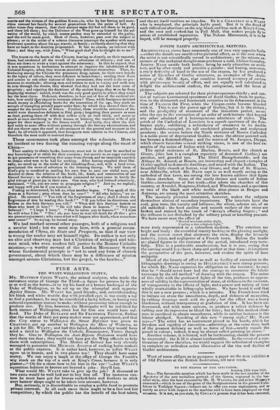JOSEPH NASH'S ARCHITECTURAL SKETCHES.
ARCHITECTURAL views have commonly one of two very opposite faults —either the details are sacrificed to pictorial effect, as is the case where the artist is not scientifically versed in architecture; or the minute ex. actness of the technical draughtsman produces a cold, lifeless formality. JOSEPH Nasir avoids both faults ; being by early education an archi. tect, and by after study and practice a painter : and having, moreover, a rea ly dextelity of baud in the use of the crayon, he has produced a series of Sketches of Gothic structures, as examples of the Arai. lecture of the Middle Ages, that combine learned accuracy of outline with picturesque beauty of effect, and are equally well calculated to delight the architectural student, the initiquariun, and the lover of pictures. The subjects are selected for their picturesqueness chiefly ; and con. sist of various Continental specimens of florid Gothic from its perfec- tion in the thirteenth aiid fourteenth centuries to its Gothic, in the time of FRANCIS the First, when the Cinque-cento became blended with it. This is not the purest age of Gothic,: but it is the richest; and the prodigality of ornament of the transition period, recon- ciles the eye to the corruption of ail order of architecture that beyond any other admitted of a heterogeneous admixture of styles. The porch of the Cathedral of Louviers is a superb specimen of the flam- boyant style ; exhibiting a redundancy of ornament in its double arches double-canopied, its tall crocketted pinnacles and sculptured pendants the screen before the North entrance of Rouen Cathedral is a noble piece of degenerated Gothic, where the obtuse pointed arch has become a flattened ellipse : and the screen of St. Jacques, Dieppe, which church furnishes several striking views, is one of the best ex- amples of the union of Italian with Gothic.
The spiral staircases of St. Maelou, Rouicri, and the church at Gisors, (this last is a complete repertory of decorated Gothic,) are peculiar, and graceful too. The Hotel Bourgtheroulde, and the Abbaye St. Amend, at Rotian, are interesting and elegant examples of Gothic applied to domestic dwellings, and mixed with the Italian. The beautiful little church at Serran, near Gisors, and that of St. Riquier, near Abbeville, which Mr. NASH says is as well worth seeing as the cathedral of that town, are among the less known edifices that figure in these sketches. Some of the costly shrines and tombs of Italian Gothic—incrustations of fret-work--that adorn the churches of this country, at Arundel, Boxgrove,Oxford, and Winchester, and a specimen or two of the black and white marble altar-pieces at Bruges and Antwerp, are among the most attractive sketches. The masterly pictorial treatment, however, makes the subjects themselves almost of secondary importance. The interiors have the cool, gray tone, the vacuity and loftiness, the silent, solemn air, of an old cathedral : the hard outline and smooth surface of the stone are broken and stained by the touch of "decay's effacing fingers ; " and the stillness is not disturbed by the solitary priest or kneeling peasant. We have never seen the effect of
storied wi,,dows Tway diglit,
Casting a dint religions light," more truly represented in a colourless medium. The exteriors are bright and lively the crumbled tracery basking in the glowing sunlight, and the narrow street that obstructs the view, display the leisurely industry, litter, and negligence of a French town. Before the tombs are placed figures in the costume of the period, introduced very taste- fully. This is a pardonable anachronism, but it is one, seeing that the carving would have. been sharp and perfect at that time; it lengthens the perspective of the past, however, and evokes the spirit of hoar antiquity. Much of the beauty of effect as well as facility of execution in the lithographic drawings is owing to HULLS! ANDE I.'S new stump process ; for which Mr. NASII expresses his obligation to the inventor he says that lie " should never have had the courage to encounter time labour necessary by the old method" of drawing with the crayon. The union of this style with the graduated lights of the tint, produces an appear- ance of solidity in the representation of stone, of richness in the costume, of transparency in the effects of light, and a power and variety of tone wholly unattainable in lithography before. We have heard it said that this is not a new process ; which is a mistake. The French have tried to imitate on stone the smoothness, depth, and richness of mezzotint,
by rubbing drawings made wills the point ; but the effect was a heavy blackness, without transparency or gradation of tint. It has been en- deavoured, and with more success, to produce a velvet richness by rubbing over the impression to blend the tints ; but by this method clear- ness is sacrificed to obtain smoothness, while in neither instance is the labour abridged. Speaking of this new " stump style," Mr. NASH. says—.." The artist has an instrument placed in his hands, which for freedom and rapidity of execution—admitting, at the same time, both of the greatest delicacy as well as force of tint—nearly equals the pencil in colour ; indeed, it may be almost called painting on stone."
Another volume, it is hinted, will be forthcoming, should the present
be successful : the &Id is almost inexhaustible. In the event of a con- tinuation of these sketches, we would suggest the selection of examples to complete an unbroken series illustrative of the rise and decline of Gothic architecture.


























 Previous page
Previous page